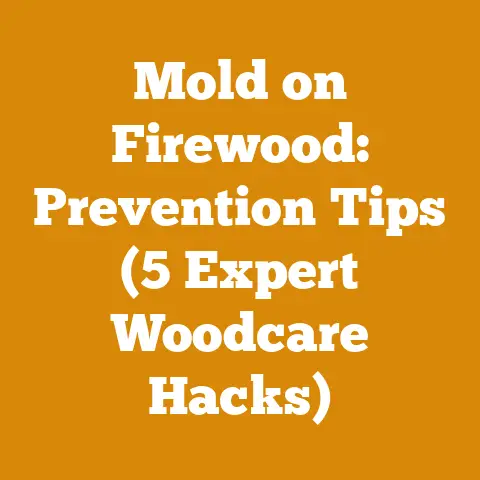Anti Creo Soot Remover Tips (5 Pro Wood Stove Hacks)
It was a bone-chilling February night, and I was nestled in my cabin, the wood stove roaring, casting a warm glow on the room. Suddenly, a loud CRACK jolted me upright. A quick inspection revealed a small chimney fire – a terrifying reminder of the dangers of creosote buildup. That night, I vowed to master creosote removal. Over the years, I’ve experimented with numerous methods, learning what works and what doesn’t. Now, I’m sharing my hard-earned wisdom with you, the five best wood stove hacks for banishing that stubborn, fire-hazard soot.
Anti-Creosote Soot Remover Tips (5 Pro Wood Stove Hacks)
Creosote. The bane of every wood-burning enthusiast. It’s a dark, tar-like substance that accumulates in your chimney as a byproduct of incomplete combustion. Left unchecked, it can lead to dangerous chimney fires. In this guide, I’ll share my top five hacks for preventing and removing creosote, ensuring a safer and more efficient wood-burning experience. These methods are based on years of personal experience and observation, blending proven techniques with a touch of innovation.
What is Creosote and Why Should You Care?
Creosote forms when smoke, unburned wood particles, and volatile gases cool as they travel up the chimney. This condensation sticks to the chimney walls, hardening into a flammable residue. There are three stages of creosote, each progressively more dangerous.
- Stage 1: Light and flaky, easily removed.
- Stage 2: Hard and crusty, requires more aggressive methods.
- Stage 3: Glazed and tar-like, extremely difficult and hazardous.
The risks of creosote buildup are significant. Chimney fires can spread rapidly, causing extensive damage to your home and potentially endangering lives. Beyond fire hazards, creosote can also restrict airflow, reducing the efficiency of your wood stove and increasing fuel consumption. Regular inspection and removal are crucial for safety and performance.
Takeaway: Creosote is a serious fire hazard. Understanding its formation and stages is the first step in combating it.
Hack #1: The Power of Dry, Seasoned Wood
This might seem obvious, but it’s the foundation of creosote prevention. I cannot stress enough the importance of burning well-seasoned wood. Green or damp wood contains a high moisture content, leading to incomplete combustion and increased creosote production.
Why Dry Wood Matters:
- Higher Combustion Temperature: Dry wood burns hotter and more efficiently, reducing smoke and unburned particles.
- Less Moisture to Vaporize: Less energy is wasted vaporizing water, allowing the stove to reach optimal temperature quickly.
- Reduced Creosote Formation: Cleaner burning means less creosote buildup in your chimney.
How to Season Wood Properly:
- Split the Wood: Splitting increases surface area, accelerating the drying process.
- Stack Loosely: Allow air to circulate freely around the woodpile.
- Elevate the Stack: Keep the wood off the ground to prevent moisture absorption.
- Cover the Top: Protect the wood from rain and snow while allowing airflow.
Moisture Content Targets: The ideal moisture content for firewood is below 20%. I use a moisture meter to check my wood regularly. These meters are relatively inexpensive and provide accurate readings. You can find them at most hardware stores for around $20-$50.
Wood Type Considerations: Different wood species dry at different rates. Softwoods like pine tend to dry faster than hardwoods like oak. However, softwoods also burn faster and produce more smoke, potentially contributing to creosote buildup if not properly seasoned.
My Experience: I once made the mistake of burning partially seasoned pine. The chimney required cleaning much sooner than anticipated. Now, I prioritize hardwoods like oak and maple, seasoned for at least 12 months, preferably longer.
Takeaway: Burning dry, seasoned wood is the single most effective way to reduce creosote buildup. Aim for a moisture content below 20%.
Hack #2: Burn Hot and Clean – The Right Way to Build a Fire
The way you build and maintain your fire significantly impacts creosote formation. A smoldering fire produces more smoke and incomplete combustion, leading to increased creosote buildup. I’ve learned that burning hot and clean is key.
Techniques for Hot and Clean Burning:
- Top-Down Fire: This method involves layering larger logs at the bottom, followed by progressively smaller kindling on top. Light the kindling at the top, and the fire burns downwards, producing less smoke and more consistent heat.
- Proper Airflow: Ensure adequate airflow to the fire. Adjust the air vents on your wood stove to allow sufficient oxygen for complete combustion.
- Avoid Overloading the Stove: Overfilling the stove can restrict airflow and lead to smoldering.
- Regularly Rake the Embers: Raking the embers ensures even burning and prevents the formation of hot spots.
Understanding Air Vents: Most wood stoves have primary and secondary air vents. Primary vents control the air entering the firebox from below, while secondary vents introduce air above the fire, promoting complete combustion of the gases released by the wood. Experiment with different vent settings to find the optimal balance for your stove and wood type.
My Experience: I used to build fires by piling wood haphazardly into the stove. The result was a smoky, inefficient burn and a rapid buildup of creosote. Switching to the top-down method and paying attention to airflow made a huge difference.
Takeaway: Build fires that burn hot and clean by using the top-down method, ensuring proper airflow, and avoiding overloading the stove.
Hack #3: The Chimney Sweeping Schedule – Prevention is Key
Regular chimney sweeping is essential for removing existing creosote and preventing dangerous buildup. I recommend inspecting your chimney at least twice a year, once before the heating season and once after.
Determining Your Sweeping Frequency:
- Wood Type: Softwoods like pine produce more creosote than hardwoods.
- Burning Habits: Frequent use and smoldering fires increase creosote buildup.
- Chimney Design: Tall chimneys and those with sharp bends are more prone to creosote accumulation.
DIY Chimney Sweeping vs. Professional Services:
- DIY: Requires purchasing a chimney sweeping kit, which typically includes a brush, extension rods, and safety equipment. Cost-effective for those comfortable working on their roof.
- Professional: More expensive but provides a thorough inspection and cleaning by a certified professional. Essential for complex chimney systems or if you’re uncomfortable with heights.
My DIY Chimney Sweeping Process:
- Safety First: Wear safety glasses, a dust mask, and gloves.
- Protect Your Home: Cover the area around the wood stove to prevent soot from spreading.
- Remove the Stovepipe: Disconnect the stovepipe from the chimney.
- Sweep the Chimney: Use the chimney brush and extension rods to scrub the chimney walls, working from the top down.
- Clean the Stovepipe: Thoroughly clean the stovepipe with a wire brush.
- Inspect for Damage: Check the chimney and stovepipe for cracks or damage.
- Reassemble: Reconnect the stovepipe to the chimney, ensuring a tight seal.
Cost Considerations: A DIY chimney sweeping kit costs around $50-$100. Professional chimney sweeping services typically range from $150-$300. While DIY is cheaper upfront, a professional inspection can identify potential problems that you might miss.
Takeaway: Establish a regular chimney sweeping schedule based on your wood type, burning habits, and chimney design. Consider DIY sweeping or hiring a professional, prioritizing safety and thoroughness.
Hack #4: Creosote Sweeping Logs – Chemical Assistance
Creosote sweeping logs are commercially available products that contain chemicals designed to loosen creosote deposits in your chimney. While they are not a substitute for physical chimney sweeping, they can be a helpful supplement. I’ve found them particularly useful for maintaining a clean chimney between professional sweeps.
How Creosote Sweeping Logs Work:
The chemicals in the log, when burned, release vapors that react with the creosote, making it more brittle and easier to dislodge. The loosened creosote then either falls into the firebox or is carried out with the smoke.
Effectiveness and Limitations:
- Effectiveness: Sweeping logs are most effective on Stage 1 and Stage 2 creosote. They are less effective on Stage 3 glazed creosote.
- Limitations: They do not remove all creosote and should not be used as a replacement for physical chimney sweeping.
- Safety Considerations: Follow the manufacturer’s instructions carefully. Ensure adequate ventilation during use.
My Experience: I use creosote sweeping logs a few times during the heating season, primarily as a preventative measure. After burning a log, I often notice a slight increase in soot falling into the firebox, indicating that it’s working.
Cost and Availability: Creosote sweeping logs are readily available at most hardware stores and online retailers. They typically cost around $10-$20 per log.
Takeaway: Creosote sweeping logs can be a helpful supplement to regular chimney sweeping, but they are not a replacement. Use them as directed and continue to prioritize physical cleaning.
Hack #5: The Baking Soda Trick – A Budget-Friendly Boost
This is a simple, inexpensive trick I learned from an old-timer. While not a standalone solution, adding baking soda to your fire can help reduce creosote buildup.
How Baking Soda Works:
Baking soda (sodium bicarbonate) is a base that neutralizes the acidic components of creosote. When added to the fire, it helps to dry out the creosote deposits, making them more brittle and easier to dislodge.
How to Use Baking Soda:
- Sprinkle on the Fire: Sprinkle a small amount of baking soda (about 1/4 cup) onto the hot embers of your fire.
- Repeat Regularly: Repeat this process every few days during the heating season.
Effectiveness and Limitations:
- Effectiveness: The baking soda trick is most effective as a preventative measure. It helps to slow down creosote buildup but will not remove existing deposits.
- Limitations: It is not a substitute for regular chimney sweeping or other creosote removal methods.
- Cost: Baking soda is inexpensive and readily available.
My Experience: I’ve been using the baking soda trick for years, and while it’s difficult to quantify its exact impact, I believe it helps to keep my chimney cleaner between sweeps. It’s a simple, low-cost addition to my creosote prevention routine.
Takeaway: The baking soda trick is a budget-friendly way to help prevent creosote buildup. Sprinkle a small amount onto the embers of your fire regularly during the heating season. Remember, it’s a supplement, not a solution.
Bonus Tip: Inspect Your Stovepipe Regularly
In addition to the chimney, I always inspect my stovepipe regularly. The stovepipe is the section of pipe that connects the wood stove to the chimney. It’s a prime location for creosote buildup, and any blockage here can significantly reduce the efficiency of your stove and increase the risk of a chimney fire.
How to Inspect Your Stovepipe:
- Visual Inspection: Look for signs of creosote buildup, such as a dark, tar-like coating on the inside of the pipe.
- Tap Test: Gently tap the stovepipe with a metal object. A hollow sound indicates that the pipe is relatively clean, while a dull thud suggests creosote buildup.
- Disassembly and Cleaning: Once a year, I disassemble the stovepipe and thoroughly clean it with a wire brush.
Safety Precautions:
- Wear Gloves and a Dust Mask: Creosote can be irritating to the skin and lungs.
- Protect Your Home: Cover the area around the stovepipe to prevent soot from spreading.
- Ensure a Tight Seal: When reassembling the stovepipe, make sure all connections are tight and secure.
Takeaway: Don’t neglect your stovepipe. Regular inspection and cleaning are essential for safety and efficiency.
Additional Considerations for Creosote Prevention
Beyond these five hacks, there are a few other factors that can influence creosote buildup.
- Stove Maintenance: Ensure your wood stove is properly maintained. Clean the firebox regularly, inspect the door gaskets for leaks, and replace any worn parts.
- Chimney Design: The design of your chimney can affect creosote accumulation. Tall chimneys and those with sharp bends are more prone to buildup.
- Altitude: Burning wood at higher altitudes can lead to incomplete combustion and increased creosote production.
- Wood Storage: Store your firewood properly to prevent it from getting wet or damp.
Takeaway: Consider all factors that can influence creosote buildup, including stove maintenance, chimney design, altitude, and wood storage.
Safety First: Important Reminders
Working with wood stoves and chimneys can be dangerous. Always prioritize safety.
- Carbon Monoxide Detectors: Install carbon monoxide detectors in your home and test them regularly.
- Smoke Detectors: Ensure your smoke detectors are working properly.
- Fire Extinguisher: Keep a fire extinguisher readily accessible near your wood stove.
- Professional Inspections: Consider having your chimney professionally inspected at least once a year.
Takeaway: Safety is paramount. Protect yourself and your family by following these safety guidelines.
Conclusion: A Clean Chimney is a Safe Chimney
Creosote is a serious threat, but with the right knowledge and practices, you can effectively manage it. By burning dry, seasoned wood, building hot and clean fires, maintaining a regular chimney sweeping schedule, using creosote sweeping logs, and employing the baking soda trick, you can significantly reduce creosote buildup and enjoy a safer, more efficient wood-burning experience. Remember, prevention is key. A clean chimney is a safe chimney. Now, get out there and put these hacks to work!






